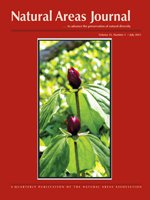Paul C. Rogers, Allison Jones, James Catlin, James Shuler, Arthur Morris, Michael Kuhns
Natural Areas Journal 35 (3), 416-427, (14 July 2015) https://doi.org/10.3375/043.035.0305
KEYWORDS: browse, forest health, monitoring, recruitment, Rocky Mountains
Quaking aspen (Populus tremuloides) forests are experiencing numerous impediments across North America. In the West, recent drought, fire suppression, insects, diseases, climate trends, inappropriate management, and ungulate herbivory are impacting these high biodiversity forests. Additionally, ecological tension zones are sometimes created at residential-wildland interfaces with divergent management directives. For example, private conservation reserves bordering public land may be degraded from browsing where game species find refuge from hunting and plentiful forage. We examined putative herbivore impacts to nearly pure aspen forests at Wolf Creek Ranch (WCR), a sparsely developed residential landscape in northern Utah. Forty-three one-hectare monitoring plots were established to measure forest attributes including site characteristics, tree and vegetation condition, and herbivore use. Additionally, we tested the ability of a plot-level visual rating system to characterize objective field measures. Results suggest elk (Cervus elaphus) herbivory is currently having a strong effect on aspen in the study area, reducing many locations to nearly single-layer aspen forests dominated by aging canopy trees. Regeneration (<2 m tall stems) is experiencing moderate to high browse impacts, and recruitment (2–6 m stems) is below replacement levels on approximately half of WCR's aspen forests. The visual rating system accurately reflected significant trends in forest cover, canopy height, plot aspect, regeneration, recruitment, and tree mortality. Ordination of plot and forest data indicated a strong negative relationship between elk presence and recruitment success. We make recommendations for addressing difficult herbivore-aspen interactions where publicly managed wildlife present barriers to conservation within residential forest reserves.

